
The Araliaceae are a family of flowering plants composed of about 43 genera and around 1500 species consisting of primarily woody plants and some herbaceous plants. The morphology of Araliaceae varies widely, but it is predominantly distinguishable based on its woody habit, tropical distribution, and the presence of simple umbels.

Meryta sinclairii, the puka or pukanui, is a large-leaved evergreen tree endemic to New Zealand that grows to about 8 m tall, with the distinctly tropical appearance typical of the genus. There are about 27 species of Meryta, all small, resinous trees of the subtropical and tropical Pacific Ocean.

Schefflera is a genus of flowering plants in the family Araliaceae. With an estimated 600–900 species, the genus represents about half of its family. The plants are trees, shrubs or lianas, growing 4–20 metres (13–66 ft) tall, with woody stems, the absence of articulated pedicels and armaments, and palmately compound leaves.

The nurse shark is an elasmobranch fish in the family Ginglymostomatidae. The conservation status of the nurse shark is globally assessed as Vulnerable in the IUCN List of Threatened Species. They are considered to be a species of least concern in the United States and in The Bahamas, but considered to be near threatened in the western Atlantic Ocean because of their vulnerable status in South America and reported threats throughout many areas of Central America and the Caribbean. They are directly targeted in some fisheries and considered by-catch in others.
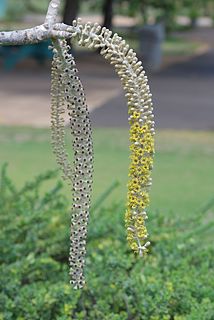
Polyscias racemosa, or false 'ohe, is a species of flowering plant in the family Araliaceae. As Munroidendron racemosum, the species was until recently considered to be the only species in the monotypic genus Munroidendron. With the change in classification, Munroidendron is now obsolete. Polyscias racemosa is endemic to the Hawaiian island of Kauai. It is very rare in the wild and some of its original habitat has been replaced by sugar cane plantations. It was thought for some time to be probably extinct, but was rediscovered a few years prior to 1967.

Alangium is a small genus of flowering plants. The genus is included either in a broad view of the dogwood family Cornaceae, or as the sole member of its own family Alangiaceae. Alangium has about 40 species, but some of the species boundaries are not entirely clear. The type species for Alangium is Alangium decapetalum, which is now treated as a subspecies of Alangium salviifolium. All of the species are shrubs or small trees, except the liana Alangium kwangsiense. A. chinense, A. platanifolium, and A. salviifolium are known in cultivation.
Arthrophyllum is a defunct genus of flowering plants in the family Araliaceae. It was recognized by most authors until 2010, when all of its 30 species were "sunk" into ''Polyscias'' subgenus Arthrophyllum.

Reynoldsia is an obsolete genus of flowering plants in the ivy family, Araliaceae. In 2003, Kew Gardens published a checklist for Araliaceae, in which eight species were recognized for Reynoldsia: four from Samoa, two from Tahiti, one from the Marquesas, and one from Hawaii. In 2010, a phylogenetic comparison of DNA data showed that Reynoldsia was polyphyletic, consisting of two groups that are not each other's closest relatives. In a companion paper, three of the species were "sunk" into synonymy with others, reducing the number of species to five. All species that were formerly in Reynoldsia are now in ''Polyscias'' subgenus Tetraplasandra, a subgenus of 21 species indigenous to Malesia and Pacific islands.
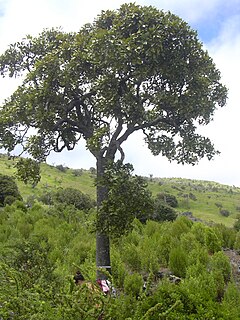
Tetraplasandra is an obsolete genus of flowering plants in the ivy family, Araliaceae. They are small to medium trees, of mesic to wet forests.
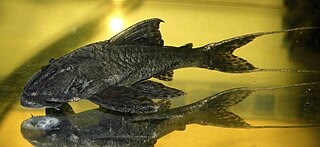
Hemiancistrus is a genus of suckermouth armored catfishes. These species are native to South America. The taxonomy of this genus is complex and unclear, and major work has to be done. Many of these fish are popular aquarium fish.

Acridocarpus is a genus of plant in family Malpighiaceae. They are native to Arabia and tropical and subtropical Africa, with one species in New Caledonia.
Polyscias scopoliae is a species of plant in the family Araliaceae. It is endemic to New Caledonia.
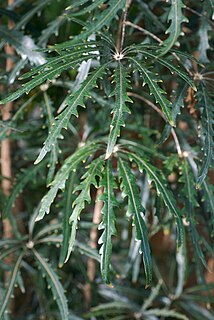
Plerandra elegantissima, the false aralia, is a species of flowering plant in the family Araliaceae, native to New Caledonia.
Peripterygia marginata is a species of shrubs in the family Celastraceae. It is endemic to New Caledonia and the only species of the genus Peripterygia. Its closest relatives are Crossopetalum and Siphonodon.
Gongrodiscus is a genus of shrubs and trees in the family Sapindaceae. The genus is endemic to New Caledonia in the Pacific and contains three species. It is related to Sarcotoechia and Storthocalyx.
Crossosperma is a genus of shrubs in the family Rutaceae. The genus is endemic to New Caledonia in the Pacific and contains two species. Its closest relative is the Australian Acradenia.
Maxwellia lepidota is a species of shrubs or trees in the family Malvaceae. It is endemic to New Caledonia and the only species of the genus Maxwellia. Its closest relatives are all Australian genera in tribe Lasiopetaleae: Guichenotia, Hannafordia, Lysiosepalum, Lasiopetalum and Thomasia.
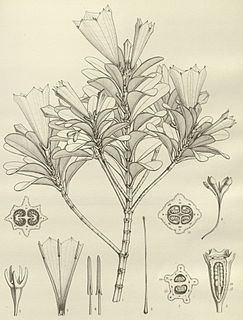
Thiollierea is a genus of shrubs in the family Rubiaceae. The genus is endemic to New Caledonia in the Pacific and contains 16 species which used to be placed in the genera Bikkia or Morierina

Depanthus is a genus of shrubs in the family Gesneriaceae. The genus is endemic to New Caledonia in the Pacific and contains two species. It is related to Negria and Fieldia.
Gastrolepis is a genus of shrubs and trees in the family Stemonuraceae. The genus is endemic to New Caledonia in the Pacific and contains two species.














